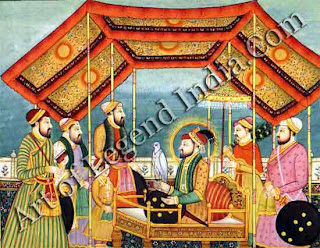 In 1526 Babur, a minor prince from Transoxiana descended from both Tamerlane and Chingiz Khan, culminated a lifetime of restless wanderings and short-lived conquests by invading India. He founded a dynasty whose autocratic power and luxurious display became proverbial as far away as England. Although its decline was to be lengthy, it endured in name at least until the banishment of the last Emperor by the British in 1858. For much of this period the cultural interests and fashions of the imperial court exercised a pervasive influence throughout the provinces, and not least on the art of painting.
In 1526 Babur, a minor prince from Transoxiana descended from both Tamerlane and Chingiz Khan, culminated a lifetime of restless wanderings and short-lived conquests by invading India. He founded a dynasty whose autocratic power and luxurious display became proverbial as far away as England. Although its decline was to be lengthy, it endured in name at least until the banishment of the last Emperor by the British in 1858. For much of this period the cultural interests and fashions of the imperial court exercised a pervasive influence throughout the provinces, and not least on the art of painting. Babur himself died in 1530, soon after his conquest. He is not known to have patronised painting during his turbulent career, but he did leave behind a remarkable volume of memoirs, whose observations of man and nature reveal an original and inquiring mind. During the reign of his bookish and ineffectual son Humayun (153o-56) the still insecure empire was lost for a time to the Pathan chief Sher Shah. Humayun was driven into exile at the court of Shah Tahmasp of Persia, who, after a carefree youth distinguished by inspired artistic patronage, was turning towards religious orthodoxy and a greater attention to matters of state. Humayun was thus able to take two of the finest Persian painters, Mir Sayyid Ali and Abd us-Samad, into his service. They accompanied him on his re-turn to Delhi in 1555, where he died only a few months later after a fall on his library staircase.
The achievement of consolidating the empire and shaping its distinctive cultural traditions belonged to Akbar (1556-1605), the third and greatest of the Mughal emperors. He possessed not only the mental acuteness of Babur but an all-embracing imperial vision and colossal physical energy with which to fulfil it. By arms and diplomacy he extended the empire and made allies of the powerful Rajputs. More than any earlier Muslim ruler, he had a receptive and tolerant intellect. Many of his generals, courtiers, wives, poets and artists were Hindus. His strong religious experiences led him to an open-minded debate with representatives of all the known faiths, including Zoroastrians, Jews and Jesuit priests. Disappointed by the animosity of these clerics, he typically chose to found an eclectic and short-lived religion centred on his own person.
Painting at Akbar's court reflected a similar forcible and dynamic synthesis between the disparate cultures of Persia, India and Europe. Akbar had himself received training from his father's two Persian masters, but the delicate refinement of the Safavid manner did not satisfy his youthful exuberance.
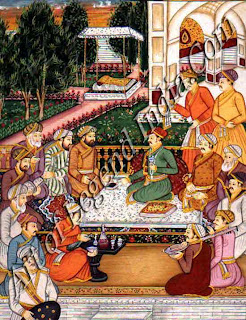 Early in his reign he set the two Persians to direct a newly recruited studio that grew to some two hundred native artists. Under his constant supervision the early Mughal style was thus formed from the fusion of Persian elegance and technique with the Indian vitality and feeling for natural forms admired by Akbar. The studio's most grandiose project, taking fifteen years to complete, was a series of 1400 large illustrations on cloth to the romance of Amir Hamza, a prolix but action-packed adventure story which was a favourite of the young Akbar. Accord-ing to one Mughal historian he would himself act as a story-teller, narrating Hainza's adventures to the inmates of his zenana (harem). In a typical, the decorative Persian tile patterns and arabesques stand in contrast to the vigorously painted trees, rocks, gesticulating figures and gory victims of the leering dragon.
Early in his reign he set the two Persians to direct a newly recruited studio that grew to some two hundred native artists. Under his constant supervision the early Mughal style was thus formed from the fusion of Persian elegance and technique with the Indian vitality and feeling for natural forms admired by Akbar. The studio's most grandiose project, taking fifteen years to complete, was a series of 1400 large illustrations on cloth to the romance of Amir Hamza, a prolix but action-packed adventure story which was a favourite of the young Akbar. Accord-ing to one Mughal historian he would himself act as a story-teller, narrating Hainza's adventures to the inmates of his zenana (harem). In a typical, the decorative Persian tile patterns and arabesques stand in contrast to the vigorously painted trees, rocks, gesticulating figures and gory victims of the leering dragon. By the time of the Hanizanama's completion in the late 157os, the Akbari style was reaching its maturity. A stream of smaller and less copiously illustrated manuscripts of Persian prose and verse classics was produced in a blander but more integrated idiom. In the last twenty years of Akbar's reign his interest turned to illustrated histories of his own life and those of his Timurid ancestors. At least five copies of Babur's memoirs were made, as well as three of the Akbarnama, Abtel Fazl's official history of his reign. As unequivocal propaganda, these and other commissions formed part of his imperial design, for they documented and legitimised what was in Indian terms still only a parvenu dynasty. The artists were more than ever required to record the court life around them in a spirit of dramatic realism. It is unlikely that the painter Khem Karan would have witnessed the siege of the Rajput fortress of Ranthainbor some twenty years previously, but his portrayal of Akbar, dressed in white, directing the attack from a promontory set against a hazy sky is a convincing presentation of the event.
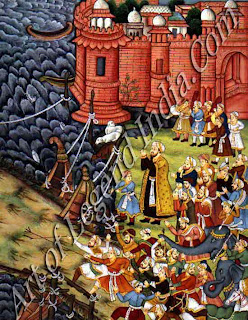 That this realism was to some extent based on a selective study of European models is shown by an illustration to the Harivamsa, one of the Hindu mythological texts which Akbar had ordered Badauni to translate into Persian, to that scholar's pious disgust. Krishna sweeps down on the bird Garuda to triumph over Indra on his elephant, watched by gods and celestial beings. The billowing clouds and swirling draperies have Baroque antecedents, while the coastal landscape with a European boat derives from Flemish art. Abu'l Fazl, besides echoing his master's praise of Hindu artists, whose 'pictures surpass our conception of things', refers also to 'the wonderful works of the European painters, who have attained world-wide fame'. He more-over tells us of an album prepared for Akbar which contained portraits of himself and his courtiers. This was the first time in Indianart that portraiture of the Western type, treating its subject as an individual character rather than as a socially or poetically determined type, had been so systematically pursued.
That this realism was to some extent based on a selective study of European models is shown by an illustration to the Harivamsa, one of the Hindu mythological texts which Akbar had ordered Badauni to translate into Persian, to that scholar's pious disgust. Krishna sweeps down on the bird Garuda to triumph over Indra on his elephant, watched by gods and celestial beings. The billowing clouds and swirling draperies have Baroque antecedents, while the coastal landscape with a European boat derives from Flemish art. Abu'l Fazl, besides echoing his master's praise of Hindu artists, whose 'pictures surpass our conception of things', refers also to 'the wonderful works of the European painters, who have attained world-wide fame'. He more-over tells us of an album prepared for Akbar which contained portraits of himself and his courtiers. This was the first time in Indianart that portraiture of the Western type, treating its subject as an individual character rather than as a socially or poetically determined type, had been so systematically pursued. In the reign of Jahangir (16o5-27) the imperial studio was reduced to an elite group of the best painters, who attended the Emperor both in court and camp to carry out his commissions. Manuscript illustration gave way to the production of fine individual pictures, whose subject matter reflected Jahangir's enthusiasms and foibles. Jahangir was a fickle character, capable both of generosity and cruelty. Inheriting a well established empire, he never developed Akbar's gifts as a statesman, and as his prodigious consumption of opium and alcohol gradually enfeebled him, the administration passed out of his hands. He also lacked Akbar's profound religious sense, being guided instead by a highly developed aestheticism. As a connoisseur of the arts, he boasts justifiably in his memoirs of his ability to distinguish even tiny details painted by different artists.
![Mughal Love Mughal Love]() He was also passionately curious about the forms and behavior of plants and animals, and it has been remarked that he might have been a better and happier man as the head of a natural history museum. When in 1612 a turkey cock was brought in a consignment of rarities purchased from the Portuguese in Goa, Jahangir as usual wrote up his observations, being particularly fascinated by its head and neck: 'like a chameleon it constantly changes colour'. His flower and animal artist, Mansur, known as 'Wonder of the Age', recorded the new specimen, rendering each feather and fold of skin with minute brushwork, against a plain background relieved only by (discoloured) streaks and a conventional row of flowers.
He was also passionately curious about the forms and behavior of plants and animals, and it has been remarked that he might have been a better and happier man as the head of a natural history museum. When in 1612 a turkey cock was brought in a consignment of rarities purchased from the Portuguese in Goa, Jahangir as usual wrote up his observations, being particularly fascinated by its head and neck: 'like a chameleon it constantly changes colour'. His flower and animal artist, Mansur, known as 'Wonder of the Age', recorded the new specimen, rendering each feather and fold of skin with minute brushwork, against a plain background relieved only by (discoloured) streaks and a conventional row of flowers.
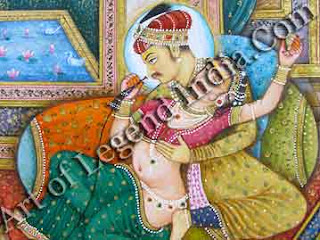 He was also passionately curious about the forms and behavior of plants and animals, and it has been remarked that he might have been a better and happier man as the head of a natural history museum. When in 1612 a turkey cock was brought in a consignment of rarities purchased from the Portuguese in Goa, Jahangir as usual wrote up his observations, being particularly fascinated by its head and neck: 'like a chameleon it constantly changes colour'. His flower and animal artist, Mansur, known as 'Wonder of the Age', recorded the new specimen, rendering each feather and fold of skin with minute brushwork, against a plain background relieved only by (discoloured) streaks and a conventional row of flowers.
He was also passionately curious about the forms and behavior of plants and animals, and it has been remarked that he might have been a better and happier man as the head of a natural history museum. When in 1612 a turkey cock was brought in a consignment of rarities purchased from the Portuguese in Goa, Jahangir as usual wrote up his observations, being particularly fascinated by its head and neck: 'like a chameleon it constantly changes colour'. His flower and animal artist, Mansur, known as 'Wonder of the Age', recorded the new specimen, rendering each feather and fold of skin with minute brushwork, against a plain background relieved only by (discoloured) streaks and a conventional row of flowers. The same qualities of dispassionate delineation and static, pattern-making composition informed the now dominant art of portraiture. Jahangir was proud of his artists' ability to emulate the technique of the English miniatures shown to him by the ambassador Sir Thomas Roe, and was delighted when Roe was at first unable to distinguish between an original miniature and several Mughal copies. The effect on Mughal painting was both refining and somewhat chilling. A scene of Jahangir receiving his son Parviz and courtiers in durbar has been skilfully assembled from individual portrait studies and stock pictorial elements such as the fountain, the simplified palace architecture, the cypress and flowering cherry' and the Flemish-inspired landscape.
![Mughal Love Mughal Love]() In this deliberate compilation there is none of the movement and interaction of figures of Akbar painting. Each finely portrayed face gazes forward in expressionless isolation an attitude which is, however, appropriate for the solemn formality of the durbar. The painting can be attributed to Manohar, the son of the great Akbari artist Basawan, who had developed a vigorous modelling technique and sense of space from European sources. In deference to Jahangir’s taste, these skills were modified by his son, who presents the outward show of imperial life, crystallized in elegant patterns and richly detailed surfaces.
In this deliberate compilation there is none of the movement and interaction of figures of Akbar painting. Each finely portrayed face gazes forward in expressionless isolation an attitude which is, however, appropriate for the solemn formality of the durbar. The painting can be attributed to Manohar, the son of the great Akbari artist Basawan, who had developed a vigorous modelling technique and sense of space from European sources. In deference to Jahangir’s taste, these skills were modified by his son, who presents the outward show of imperial life, crystallized in elegant patterns and richly detailed surfaces.
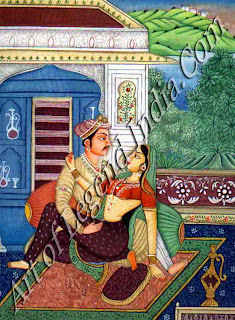 In this deliberate compilation there is none of the movement and interaction of figures of Akbar painting. Each finely portrayed face gazes forward in expressionless isolation an attitude which is, however, appropriate for the solemn formality of the durbar. The painting can be attributed to Manohar, the son of the great Akbari artist Basawan, who had developed a vigorous modelling technique and sense of space from European sources. In deference to Jahangir’s taste, these skills were modified by his son, who presents the outward show of imperial life, crystallized in elegant patterns and richly detailed surfaces.
In this deliberate compilation there is none of the movement and interaction of figures of Akbar painting. Each finely portrayed face gazes forward in expressionless isolation an attitude which is, however, appropriate for the solemn formality of the durbar. The painting can be attributed to Manohar, the son of the great Akbari artist Basawan, who had developed a vigorous modelling technique and sense of space from European sources. In deference to Jahangir’s taste, these skills were modified by his son, who presents the outward show of imperial life, crystallized in elegant patterns and richly detailed surfaces. Court portraiture under Shah Jahan (1627-58), exemplified by the Padshahnama, the illustrated history of his reign now at Windsor Castle, and became still more formal and frigid. Each durbar, battle or procession is a grand compilation of countless individual portraits, painted with a hard, immaculate finish. The effect is magnificent but heartless and strangely unanimated. Shah jahan's real passion Was for jewels and architecture: on these he lavished much of the wealth of the empire, combining them above all in the justly celebrated Taj Mahal. Album paintings of varied subjects were, however, still produced, such as a genre scene of an informal musical party by Bichitr, an artist best known for his accomplished portraiture and cool palette. The painting is in fact an exercise in the style of Govardhan, another Hindu and one of the most gifted of all Mughal painters, excelling at keenly observed group portraits of common people and particularly of holy men as well as kings.
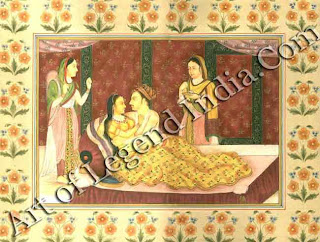 In 1658 Shah Jahn was deposed by his third son, the pious and puritanical Aurangzeb, and Dara Shikuh, the more free-thinking and artistically inclined heir apparent, was put to death. During his long reign (1658-1707) Aurangzeb further dissipated the empire's resources, not like his father by immoderate luxury and building projects, but by interminable military campaigns in the Deccan. The court arts languished for want of patronage, and from 168o onwards many painters took service at provincial courts. A urangzeb was followed in the 18th century by a succession of effete incompetents who maintained an illusory show of power while the empire broke up. The sybaritic Muhammad Shah (1719-48), who when told of some defeat would console himself by contemplating his gardens, was typical of the age. In 1739 he endured the humiliating sack of Delhi by Nadir Shah of Persia. A nautch (dancing-party) scene in his zenana shows signs of the brittle rigidity and vapid sensuality of late Mughal painting, which preserved much of the technique of the mid-17th century style, but had little new to say. The emperors after Akbar had insulated themselves within the increasingly formal and introverted microcosm of court life.
In 1658 Shah Jahn was deposed by his third son, the pious and puritanical Aurangzeb, and Dara Shikuh, the more free-thinking and artistically inclined heir apparent, was put to death. During his long reign (1658-1707) Aurangzeb further dissipated the empire's resources, not like his father by immoderate luxury and building projects, but by interminable military campaigns in the Deccan. The court arts languished for want of patronage, and from 168o onwards many painters took service at provincial courts. A urangzeb was followed in the 18th century by a succession of effete incompetents who maintained an illusory show of power while the empire broke up. The sybaritic Muhammad Shah (1719-48), who when told of some defeat would console himself by contemplating his gardens, was typical of the age. In 1739 he endured the humiliating sack of Delhi by Nadir Shah of Persia. A nautch (dancing-party) scene in his zenana shows signs of the brittle rigidity and vapid sensuality of late Mughal painting, which preserved much of the technique of the mid-17th century style, but had little new to say. The emperors after Akbar had insulated themselves within the increasingly formal and introverted microcosm of court life.  Given inspired patronage, painting had for a time flourished in this hot-house atmosphere, but when the empire was played out it too gradually declined into a repetition of well worn themes, both at Delhi and at the provincial courts of Lucknow and Murshidabad. After Clive's victory in Bengal in 1757, British power began to spread across northern India, and by the early 19th century Delhi artists were emulating the style of painting favoured by the new imperialists. A nautch party of this period is set in a European mansion with classical columns and pediments. The figures also arc in the Europeanised 'Company' style, but the Indian artist has, resourcefully as ever, transformed the alien conventions of modelling and recession into his own umistakable idiom.
Given inspired patronage, painting had for a time flourished in this hot-house atmosphere, but when the empire was played out it too gradually declined into a repetition of well worn themes, both at Delhi and at the provincial courts of Lucknow and Murshidabad. After Clive's victory in Bengal in 1757, British power began to spread across northern India, and by the early 19th century Delhi artists were emulating the style of painting favoured by the new imperialists. A nautch party of this period is set in a European mansion with classical columns and pediments. The figures also arc in the Europeanised 'Company' style, but the Indian artist has, resourcefully as ever, transformed the alien conventions of modelling and recession into his own umistakable idiom.Writer – Andrew Topsfeld
